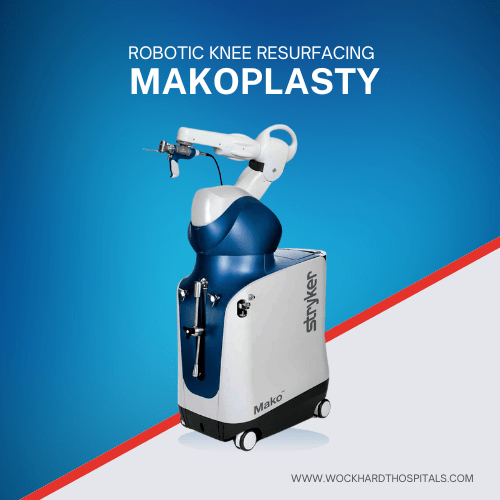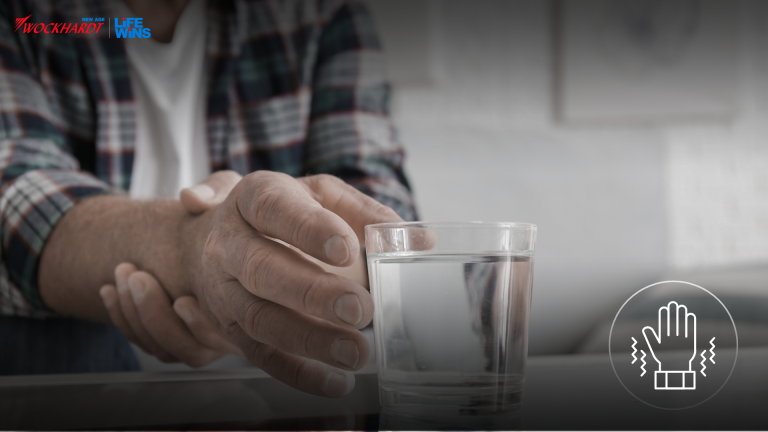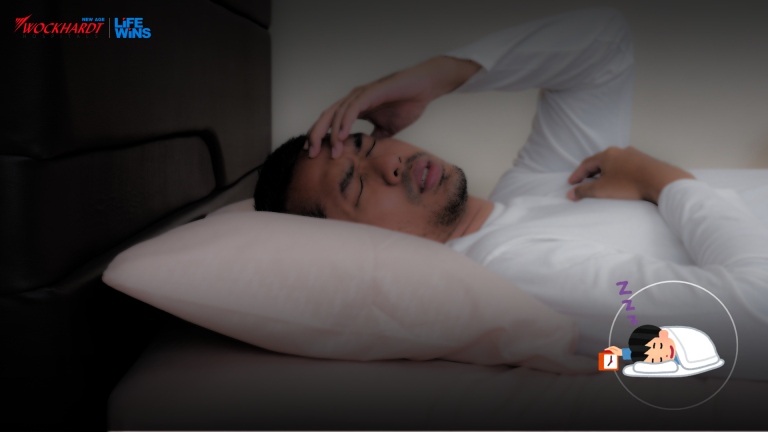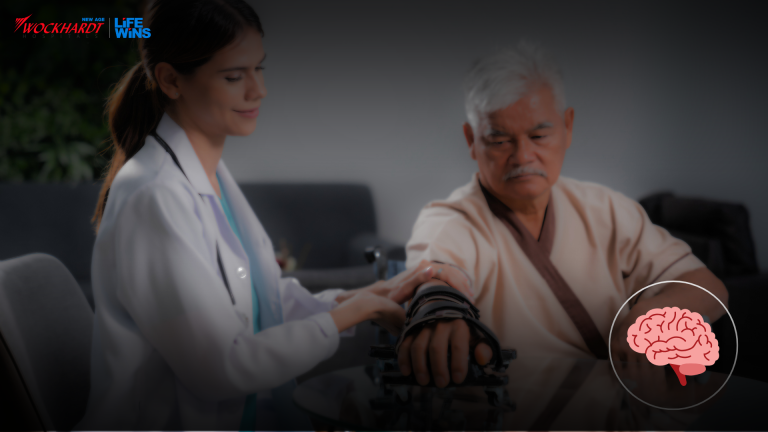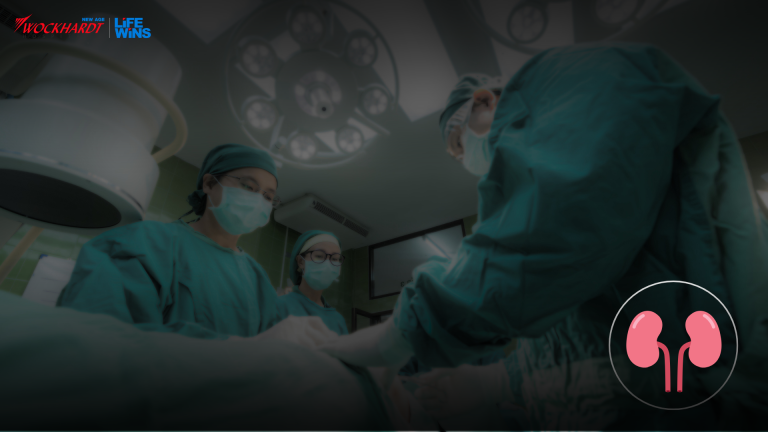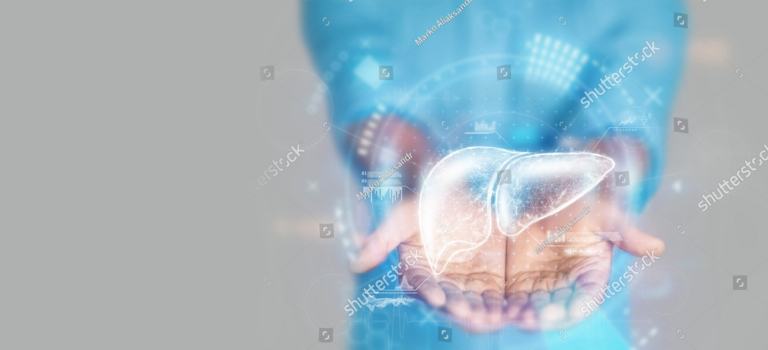Safe guard from Falling Ill in the Monsoons

Mumbai welcomes the monsoon season after the scorching heat once again. But as we are aware apart from the pleasant weather the season brings many diseases like typhoid, dengue, malaria, common cold, skin infection due to the damp and unhygienic conditions during this time. Furthermore, this season takes a toll on one’s immune system making us susceptible to these infections and allergies. Let’s have a look at some simple yet effective health tips for Monsoons that can make the season even more enjoyable without worrying. In case you are experiencing any signs and symptoms associated with common monsoon ailments do visit us at Wockhardt Hospitals.
Most Common Monsoon Diseases, Their Treatment & Prevention

The monsoons bring a relief from the scorching heat during the summers but with their respite, they also bring along with them various maladies. Every monsoon season, the risk of catching various diseases is extremely high due to unhygienic conditions and not adhering to basic preventive measures. Many of these monsoon diseases remain undiagnosed until they progress to undesirable complications. This is why early diagnosis and treatment of diseases in rainy season is important making the difference between life and death. Here are some common diseases which are highly prevalent during this season that you should be aware about. It is also advisable to understand the preventive measures of these diseases and precautions that you and your family can take as well. Influenza (Cold and Flu): Common cold is one of the most commonly occurring during the monsoon season. It is highly contagious disease due to the spread of virus in the air which infects the upper respiratory tract and thus affects the nose and the throat. Symptoms involve runny or stuffy nose, body ache, throat irritation and soreness and fever. It is always advisable to consult a physician and get the required medicines prescribed for getting cured from the infection The best way to prevent common cold is to have a healthy, balanced and nutritious diet regular which will develop the immune system of the body and improves the body resistance. Cholera: Another most common and deadly bacterial disease that spreads during monsoon is “cholera” This disease is caused by contaminated food and water and also poor hygienic conditions .Common symptoms of cholera are severe diarrhoea with watery stool ’rice water stools” and vomiting which causes immediate water loss and muscle cramps. Diarrhoea can be so severe that it leads within hours to severe dehydration and electrolyte imbalance. A rapid dipstick test is available to determine the presence of V. cholera bacteria from stool sample Cholera requires immediate treatment because the disease can cause death within hours. The goal is to replace lost fluids and electrolytes using a simple rehydration solution, oral rehydration salts (ORS). The ORS solution is available as a powder that can be reconstituted in boiled or bottled water. Antibiotics are not a necessary part of cholera treatment. Preventive measures include providing clean drinking water, better sanitation, and better handwashing Typhoid: “Typhoid” is another waterborne bacterial infection caused by bacteria called Salmonella. This disease is caused by contaminated food or drinking food or water contaminated with the faeces of an infected person. Diagnosis is made by any blood, bone marrow or stool cultures and with the Widal test. Symptoms of the diseases are prolonged high fever, severe abdomen pain, headache; vomits are common symptoms of this disease. The worst part is that the infection of this disease can remain in the gall bladder of the patient even after he/she is cured. Preventive measures include providing clean drinking water, better sanitation, and better handwashing. Treatments of typhoid include antibiotics such as azithromycin, fluoroquinolones or third generation cephalosporin. Hepatitis A: Hepatitis A is a highly contagious liver infection caused by the hepatitis A virus. It is a waterborne viral infection is generally caused by contaminated drinking water or food with the stool of someone with the virus, it can spread through flies. Eating fruits, vegetables, or other foods that were contaminated during handling can cause spread of infection. The symptom of this disease is directly related to the inflammation of the liver that’s caused by a virus. Symptoms include, Jaundice (yellow eyes and skin, dark urine), stomach pain, Loss of appetite, Nausea, Fever, Diarrhoea and Fatigue. Blood tests are used to detect the presence of hepatitis A in your body. No specific treatment exists for hepatitis A.. In most cases of hepatitis A, the liver heals within six months with no lasting damage .Management involves, Rest, treatment of nausea and rest to liver. Practicing good hygiene, including washing hands frequently, is one of the best ways to protect against hepatitis A. Vaccines are available for people most at risk. Dengue: Dengue fever is a disease caused by a family of viruses that are transmitted by mosquitoes. It is spread by what’s known as the tiger mosquito (Aedes Aegypti), which has black and white stripes and typically bites early in the morning or at dawn. Dengue goes by other names, including “break bone fever. Symptoms of dengue fever include severe joint and muscle pain, swollen lymph nodes, headache, fever, exhaustion, and rash. Complication of dengue fever is called Dengue haemorrhagic fever (DHF). It is a specific syndrome that tends to affect children under 10 years of age. This complication of dengue causes abdominal pain, haemorrhage (bleeding), and circulatory collapse (shock). There are no specific antibiotics or antiviral medication to treat it. For typical dengue, the treatment is concerned with relief of the symptoms and signs. Rest and fluid intake (oral rehydration) are important. Pain relievers such as aspirin and nonsteroidal anti-inflammatory drugs should only be taken under a doctor’s supervision because of the possibility of worsening bleeding complications. Pain killers can be given for headache and for joint and muscle pain (myalgia). Platelet count should be monitored through the course of the illness. Sometimes hospitalization for dengue maybe advised depending upon the patient’s condition receive IV fluids. Preventive measures -As it’s transmitted via mosquitoes, one should wear a strong insect repellent containing DEET to prevent getting bitten. -People should also wear full sleeve clothing when out in the day. – It is important to remember that the dengue mosquito usually bites only in the day time and breeds in clean, fresh water. So any water accumulation should be avoided. Malaria: One of the most common monsoon-related diseases, malaria, is caused by certain species of mosquitoes breeding in the dirty water. Since, there is a problem of water logging during the rainy season, mosquitoes get conducive conditions to breed .This disease is spread by Female Anopheles mosquito. Most deaths are caused by P. falciparum and is the most dangerous
Brain Tumour & Neuro-Oncology Services
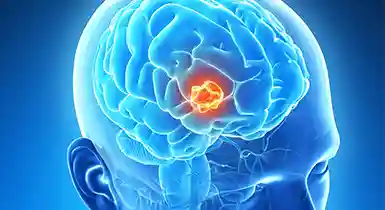
A brain tumour is a mass or growth of abnormal cells developing in the brain. They can be benign or malignant. The tumours can be primary brain tumours originating in the brain itself or in tissues close to it, such as in the brain-covering membranes, cranial nerves, pituitary gland or pineal gland. Sometime tumour can be a secondary lesion from another cancer in the body and spreads to the brain. Brain tumours can grow rapidly and affect well the function of your nervous system. General signs and symptoms include the signs and symptoms of a brain tumour vary greatly and depend on the brain tumour’s size, location and rate of growth. Headaches are very common, they can be new in onset or there can be changes in pattern of headaches .They can be become more frequent and more severe Sometimes there are episodes of unexplained nausea or vomiting. Vision problems, such as blurred vision, double vision or loss of peripheral vision are quiet common. Gradual loss of sensation or movement in an arm or a leg depending on the lesion .Difficulty with balance and speech difficulties can be associated with tumour lesions. Confusion in everyday matters and personality or behaviour changes is also noticed. Seizures, especially in someone who doesn’t have a history of seizures can also occur. Hearing difficulties are sometimes observed. Diagnosis of brain tumours can generally be carried through a neurological examination. Diagnosis can be carries though CT scans, MRI, PET scan and through biopsies. These are generally advised by a neurologist or neurosurgeon. Neuro-Oncosurgery at Wockhardt Hospital: Neuro-oncology is a sub-specialization that deals with brain tumours and spinal cord tumours. These tumours can be both benign (non-cancerous) or malignant (cancerous). Malignant tumours can be divided into primary – that arise from within the brain and spine and secondary tumours – that have spread to brain and spine from other body parts, known as metastatic tumours. All types of brain and spinal cord tumours may produce symptoms that vary depending on the part of the brain and spinal cord involved. With the advancement of technology (advanced microscopes, intraoperative navigation) and better investigation facilities, the morbidity and mortality associated with the brain and spine surgeries has drastically decreased in last two decades. Treatment of benign brain and spinal cord tumours is done by surgical excision, whereas, in case of malignant brain and spinal cord tumours, either chemotherapy or radiation therapy is required, in addition to surgery. Common benign tumours of brain are meningioma, acoustic neuroma, schwannoma and pituitary tumours. Pituitary tumours can be removed through nose with endoscope or microscope without opening the skull. Generally surgery is suggested for the following in case of brain tumours. Need for surgery: Some surgical techniques include: Craniotomy: Cranioplasty surgery is the most common surgical procedure for excision of brain tumour. An area of the bone is cut out from the skull, the tumour is removed. The whole process is guided by MRI or CT scans either before the surgery or during the surgery. Neuroendoscopy: It also called keyhole brain surgery is done by making small opening in the brain with the aid of endoscope. Neuroendoscopy enables neurosurgeons to access areas of the brain that cannot be reached with traditional surgery and remove the tumour without cutting or harming other parts of the skull. The procedure is performed using an endoscope, a small telescope-like device equipped with a high-resolution video camera and eye piece on the end to allow the neurosurgeon to navigate and access the tumour. For more information on brain tumours symptoms, diagnosis and treatment contact our centres at Wockhardt hospital.
Hair Transplant Solutions

Hair transplant surgery in India is fast becoming a popular choice of procedure for both men and women .Your hair is a statement of who you are; your status, age and position in society. Losing your hair can lead to frustration, anxiety and depression and finding a hair loss solution has also become vital for some patients. Hair transplant through hair restoration surgery is now getting quiet popular in India. Patients are generally evaluated if they can be a candidate for the hair transplant surgery in India. A hair transplant is a surgical procedure to improve baldness and hair loss with hair restoration techniques. It is a novel and innovative technique for hair restoration in India and is regarded as advancement in the fields of cosmetology for treatment of hair loss and restoration. Cost of hair transplant in India of course depends on the hair transplantation technique determined. Hair transplant restoration surgery varies from range is between 35000 to 80000 rupees. Hair fall causes: Alopecia is the general medical term for hair loss. At Wockhardt Hospitals we understand that hair loss could be hampering your appearance and outlook towards life. Our specialised centres are well equipped to carry out the procedure for hair transplant including hair restoration techniques and help you regain your confidence and aesthetic aspect of your life, that maybe a major concern to you. Our Hair & Skin Academy is a modern, advanced, comprehensive & state of the art facility which offers truly innovative therapies for management of Hair loss. This has been setup with an objective of providing latest therapies, procedures & solutions for hair loss patients in a manner which is transparent, scientific evidence driven, & adheres to the highest standards of quality. Wockhardt hair clinic is an aesthetic setup housed inside Wockhardt hospitals which is in exclusive association with Partners Medical Internationals, Boston, USA. Wockhardt hair clinic utilises the expertise of qualified plastic surgeons, dermatologists and technician having years of hands-on experience. Wockhardt Hair Clinic has one of the best infrastructures and is well supported by an in-house state of the art emergency & ICU services which can be availed in hair transplant solutions. The hair surgical restoration techniques are performed only by plastic surgeons. Our hair transplant surgeons’ relevant degrees & intensive training & experience in hair transplant surgeries. Who is a good candidate for hair restoration surgery? Types of Hair Restoration Methods offered at Wockhardt Hospitals: In this type of hair transplant surgery in which a strip of follicular units is taken from the donor site, dissected and then placed in the recipient site. This hair transplant procedure either uses the strip harvesting method or a form of direct extraction called follicular unit extraction. A follicular unit is a naturally occurring cluster of hair follicles in the scalp. A unit can consist of 1, two or three hairs and on a few rare occasions, four hairs. Body Hair Transplant (BHT) uses the same principles of extraction as FUE, but the hair is extracted from various parts of the body and not from the scalp. BHT is a relatively new form of hair replacement; and in certain special situations it may be considered for hair restoration Micro hair pigmentation, also named Tricopigmentation, is a non-surgical treatment which uses the latest technology to create the effect of a full head of hair. This hair transplant restoration technique is desired in case you are too young for a hair transplant, bad donor area, faster result, and not a candidate for surgery. All these procedures & surgeries have been well studied & established. The results have been documented & published over a period of time hence there is no doubt about the usefulness & efficacy of the treatment if done properly & by experts. But at the same time it’s important to understand that each human body responds differently to any therapy hence it’s difficult to guarantee any outcome. Being well informed regarding various aspects of hair loss, restoration etc and having realistic expectations from the procedure increase the chances you will be happy with the results. To know and understand more about Hair transplant surgery please visit our Hair and Skin Academy at Wockhardt Hospitals. Wockhardt Hospitals is regarded as a centre of excellence the healthcare domain, having facilities in North Mumbai (Mira road), South Mumbai (Mumbai Central), Navi Mumbai (Vashi), Nagpur, Nasik, Rajkot and Surat. Wockhardt Hospitals has state-of-the-art infrastructure. Our prime objective is patient safety and quality of care at all levels. The guiding philosophy is to serve and enrich the Quality of Life of patients and to make life win.
International Women’s Day: 8 March, 2024

A 32 year old female was complaining of discomfort & reducible swelling in right inguinal (groin) area labial region since 6 months. She visited many hospitals to understand the reason for her swelling, but her diagnosis turned out inconclusive by doctors. The patient was concerned and was referred to Wockhardt Hospitals for their clinical evaluation to Dr Aditi Agrawal. Dr Aditi Agrawal is an established General Surgeon having a decade of experience in her specialty. She has a rich experience of all General Surgeries. She has performed all kinds of open and laparoscopic surgeries including advanced surgeries and specialises in female gynaecological surgeries when referred. On examining the patient, Dr Aditi advised certain investigations. A pelvic sonography revealed a cystic mass in pelvic area and ovary was not visible on right side. To confirm the diagnosis a CT and MRI scan was done. Diagnosis was ascertained as a hydrocele Hydrocele of the Canal of Nuck (Female Hydrocele), which generally creates an Inguino-Labial Swelling. The inguinal canal is traversed by the round ligament of uterus in women. The round ligament attached with a fold from peritoneal cavity presents as swelling in groin area. Hydrocele of the canal of Nuck is a rare condition in females .Such cases are equivalent of a spermatic cord hydrocele in males (encysted hydrocele). A hydrocele is an accumulation of serous fluid in a body sac and seen in men and females. For management and further treatment of this patient a diagnostic laparoscopy was performed with hernia repair. Patient was discharged after favourable conditions and follow up was advised. For any women related health issues please visit us at Wockhardt Hospital. Case 2 A Gastrointestinal disorder diagnosed by surgeon at Mira road, helps an elderly lady patient A 72 year old female was suffering with a rare condition for last 3 months. She was not able to swallow food and had stopped eating solid foods and was on a liquid diet. She was undergoing considerable weakness and weight loss. Soon she developed a complete loss of appetite and was vomiting. She was referred to Wockhardt Hospital for ascertaining a diagnosis of her condition. The patient was advised a CT scan and a polyp was discovered with impacted food residue. Further to this an Upper GI endoscopy was carried out to confirm the diagnosis. Dr Aditi Agrawal, a general surgeon at Mira Road decided that the surgical removal of the polyp through Gastrostomy was the only line of treatment. Medically this condition of entrapment of food in a mass is called PHYTOBEZOAR. It is a trapped mass in the gastrointestinal system that consists of components of indigestible plant material, such as fibres, skins and seed etc. This condition is one of the unusual causes of small bowel obstruction in a patient. Generally the treatment of small bowel obstruction is surgery. Prevention includes avoidance of high fibre diet, prokinetics particularly in patients who have undergone gastric surgery. After surgery patient was stable and was advised a follow up, diet to be maintained. Patient has now recovered and is tolerating meals. For further queries regarding any gastrointestinal complaints please visit us at Wockhardt Hospital. Case 3 Multifactorial causes determined by Surgeon at Mira Road helps improve life of female patient. A 42 year old female, developed bleeding from umbilicus region and was associated with severe lower abdominal pain since 15 years. She had been suffering from other gynaecological symptoms in addition to this which were infertility, irregular menstruation and dysmenorrhoea. On examination with a surgeon, Dr Aditi Agrawal at MIRA Road Wockhardt Hospital, a 3 cm nodule at the umbilicus was discovered. A CT scan abdomen was advised. The CT scan report showed a nodule at the umbilicus with multiple fibroids in the uterus. On Histopathology investigation endometriosis was ascertained. The condition is called Weeping Umbilicus .The course of treatment planned was an excision of the umbilicus nodule with reconstruction along with hysterectomy to alleviate the patient symptoms and give a better quality of life to her. After the surgery a 3year follow up was planned and the patient has now recovered. For any women related issue please visit us at Wockhardt Hospital.
World Cancer Day 2024: February 4
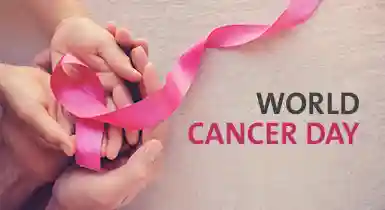
World Cancer Day is an international day marked on 4 February to raise awareness of cancer and to encourage its prevention, detection, treatment and surgeries. World Cancer Day is led by the Union for International Cancer Control to support the goals of the World Cancer Declaration. Beating cancer and surviving it with self-confidence. Cancer cells are abnormal cells that grow uncontrollably forming a mass called a tumour anywhere in the body. As per statistics The Indian Council of Medical Research finds that India is likely to have more than 17.3 lakh new cases of cancer and over 8.8 lakh deaths due to the disease by 2020. Breast cancer is the most common of the types of cancers occurring in India followed by lung cancer and cervical cancer in India today. Cancer is a difficult journey, both for the one who is suffering as also their care givers. We at Wockhardt Hospital firmly believe that with correct diagnosis and treatment plan, cancer can be beaten giving a patient an opportunity for a new lease to life. A 55 year old lady suffering was diagnosed of breast cancer changing her predicament in life, visited Wockhardt Hospital South Mumbai for treatment. Generally women discover Breast Lumps on self-examination which is first sign or symptom of breast cancer breast along with various skin changes. On mammography breast cancer can also be detected. Breast cancer can spread when the cancer cells get into the blood or lymph system and are carried to other parts of the body and can then be fatal. Understanding the crisis and life changing circumstances that she might face as part of the treatment she requested the doctors at Wockhardt Hospital, South Mumbai to preserve her breast tissue and not undergo radiation therapy. The psychological impact of breast cancer alone can be so daunting to a patient and for some the thought of losing their natural appearance can further increase the stress and plight of the patient undergoing the treatment modalities. The adverse effects of radiation on the patient are also severe. Radiotherapy causes side effects because it affects healthy tissue as well as cancer cells. Although most side effects are temporary, some may be permanent and some can appear months or even years after treatment finishes. These changes can be skin changes around the breast with swelling and a general feeling with tiredness. Removal of the breast through mastectomy though lifesaving can change the complete outward appearance as well. The doctors understood the patient’s dilemma and decided to plan alternative mode of treatment. She was deemed a fit candidate for the Breast Reconstruction Surgery and radiation was avoided. The breast surgery was carried out by our skilled surgeons Dr Meghal Sanghvi and Dr. Akshay Deshpande at Wockhardt Hospitals, South Mumbai. Women who have surgery as part of their breast cancer treatment may choose breast reconstruction surgery to rebuild the shape and look of the breast. The benefits of breast reconstructive surgeries are to permanently regain the breast shape and after a mastectomy. Breast reconstruction can make one feel better renewing her self-confidence. Certain factors such as healing, overall health status of the patient and the extent of the cancer are taken into consideration before the surgery. Presently the patient is undergoing chemotherapy under the guidance of the senior oncologists, Dr Padiwala a renowned oncologist at Wockhardt hospital, South Mumbai. The patient’s life is proceeding as normal after the reconstructive surgery and there keeping intact her self-assurance and reviving hope. To know more about breast cancer, its detection, cancer awareness and options of treatment visit us at Wockhardt Hospitals. Oncology Services at Wockhardt Hospitals: Wockhardt Hospitals, a chain of tertiary care super-specialty hospitals has more than 25 years of experience in the creation and management of Super Specialty Hospitals in India. Wockhardt Hospitals have been regarded as centers of excellence in medical science with facilities in North Mumbai (Mira road), South Mumbai (Mumbai Central), Navi Mumbai (Vashi), Nagpur, Nasik, Rajkot and Surat. Wockhardt Hospitals is having state-of-the-art infrastructure whose prime objective is patient safety first and quality of care at the core of its strategy. The guiding philosophy is to serve and enrich the Quality of Life of patients and to make life win. At Wockhardt Hospital we believe that diagnosis and management of a cancer patient does not end with the treatment of cancer, and hence it follows a well-designed patient counselling services and support system and forms part of goals in our oncology department. Our oncology team at Wockhardt Hospital uses cutting edge technology & latest pharmaceuticals to provide complete treatment for of cancer. At Wockhardt Hospitals our esteemed and dedicated team of oncologist team, provides both inpatient and outpatient services for patients diagnosed with cancer. This care is delivered by a multidisciplinary team of oncologists working together. Our oncologists at Wockhardt hospital along with expertise in this vast field and supported with advanced technology assist in providing the best quality patient care to our cancer patients in administration of chemotherapy and radiation oncology. The Department of Surgical Oncology is the only surgical oncology department for cancer treatment aims to provide holistic, all round surgical care for solid tumours comprising of Head & Neck Cancers, Breast Cancer and Cancers of the female reproductive organs. Our qualified surgeons all have specialized fellowship training and work in a multidisciplinary setting with other specialists to provide the latest treatments and innovations in surgical cancer care. Our centres at Wockhardt Hospital also provide the nutrition support and other therapies to manage the side effects of cancer treatment. Why Choose Wockhardt Hospitals for Cancer Treatment and Surgery? The successful establishment of Wockhardt Hospitals is the result of a 50-year legacy of healthcare and innovation nurtured by Wockhardt Ltd., the 5th largest pharmaceutical and medical institution in India with a presence in 20 countries worldwide. The Department of Medical Oncology at Wockhardt Hospitals provides adults and children with solid tumors and blood cancer with comprehensive care in diagnosing and treating their conditions. In addition to medical, surgical, radiation therapy, and bone marrow
Winter Related Diseases
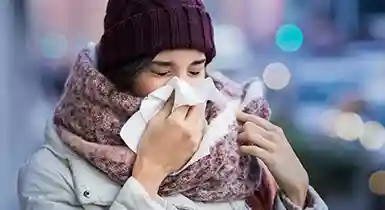
The winter season brings a chill in the air and one tends to feel pleasant. However, it is better to watch out for certain ailments that usually accompany the drop in temperature. It is a well-known fact that disease such as arthritis and heart diseases can worsen during this period. But cold-related ailments including respiratory and skin conditions and many more can flare up or even worsen. Let’s take a look at some conditions that you can suffer from during the winter months. 1)Respiratory conditions such as upper and lower respiratory tract infections like common cold, flu and viral or bacterial pneumonia can occur commonly. Respiratory conditions such as asthma and chronic bronchitis may worsen during the cold season. The main source of infection is inhaling droplets with the concerned organism exhaled by already infected cases are sources of infection or low immunity Conservative line of treatment is the best way to cure these types, keep yourself warm, take rest and hydrate yourself adequately with warm fluids. Antibiotics rarely help as most of the infections are likely to be due to viruses which do not respond to them. In case of pre-existing asthma and bronchitis keep yourself warm, and take their medications and inhalers regularly. 2)Dryness of skin in the winter season is extremely common. This can lead to intense itching, especially on the shin, thighs, trunk and arms. Eczema and psoriasis can worsen during winters. The best line of treatment is to keep your skin moisturized at all times. If possible try to get some sun exposure. In addition to diet and exercise, if you keep yourself and the house warm, expose yourself to as much sun as possible, and do breathing exercises and meditation to regularise the breathing pattern, the impact of winter-related ailments could be significantly reduced. 3) Stomach Flu very common during winter months. When your immune system becomes weak, your body faces difficulty in fighting against the effects of bacteria. The most common symptoms of stomach infection include vomiting, excessive thirst, green stool, fever, diarrhoea, loss of appetite and pain the abdominal area. It’s a self-treatable ailment and does not require any specific course of treatment. During the infection following is advised: 4) Heart Attack If you have an underlying heart condition please takes maximum precautions during the winter months. During the winter season many breathing problems occur, which directly or indirectly increase the chances a person suffering from a heart disease. Here are some awareness tips to guide you for preventing the same: 5) Pneumonia: It’s a lung infection caused by fungi, bacteria, or viruses. Doctors suggest that symptoms of Pneumonia must not be ignored or taken lightly, for if the infection is not treated at the earliest, it can gravely hamper the functionality of the lungs, the brain and many related organs of the body. In case of signs and symptoms of pneumonia please consult your doctor includes as follows: 6) Bronchiolitis: Caused by a viral infection that disturbs the air passages in the lungs, affecting children and appears in infants, but affect adults as well. It seems quite similar to a common cold, but as the condition progresses, it causes a breathing problem. Symptoms of bronchiolitis are as follows Fatigue, Vomiting, Cough, Fast breathing, Sluggish appearance, wheezing. In case the conditions worsen please visit your doctor. 7) Throat Infection: Symptoms start with painful, itchy and scratchy throat that makes us uncomfortable. Most throat infections are a result of a persisting infection or some environmental factors, such as dry air. Gargling, rest, and avoiding cold items will help. 7) Allergic Asthma: Allergic asthma, as the name suggests, is a condition wherein an individual suffers from an asthmatic condition as a result of an allergic reaction. Individuals with allergic asthma usually experience symptoms as soon as they inhale an allergen the patient as breathlessness on rest with increased respiratory rate. Some basic tips to prevent asthma: 9) Raynaud’s Syndrome: It is a condition wherein the flow of blood to your fingers, toes, nose, and ears gets restricted. This typically happens when the blood vessels present in these areas constrict. Common symptoms include colour changes in the skin, stinging pain and stress. Some tips to prevent this include: 10) Arthritis: Joint pain in winter results due to stiffness of muscles. During winter people tend to stay indoors getting very little exercise and hence making muscles stiffer. Those suffering from Arthritis also complain that winter worsens their condition. The pain can get worse in case one has suffered joint injuries. Some tips to ease the pain: In case you are experiencing any of signs or symptoms and need treatment or would like to know please contact our centres at Wockhardt Hospital. Wockhardt Hospitals is one of the countries premium hospitals that are focused on the prevention, diagnosis and treatment of medical conditions. Wockhardt Hospitals, a chain of tertiary care super-specialty hospitals has more than 25 years of experience in the creation and management of Super Specialty Hospitals in India. Wockhardt Hospitals is regarded as a centre of excellence the healthcare domain, having facilities in North Mumbai (Mira road), South Mumbai (Mumbai Central), Navi Mumbai (Vashi), Nagpur, Nasik, Rajkot and Surat. Wockhardt Hospitals has state-of-the-art infrastructure. Our prime objective is patient safety and quality of care at all levels. The guiding philosophy is to serve and enrich the Quality of Life of patients and to make life
International Day of Persons with Disabilities: 3 December, 2024
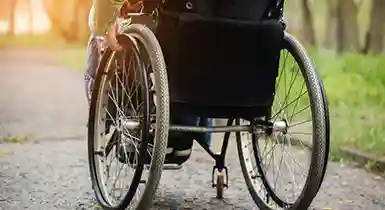
The International Day of People with Disability is celebrated on December 3 every year. The day promotes awareness about people with disabilities as well as encourages them by implementing a lot of assistance in their real lives to enhance their way of life and remove the social stigma towards them. The theme for 2024 is “Transformative Solutions for Inclusive Development: the role of Innovation in Fuelling an Accessible and Equitable World “. What is International Day of Persons with Disabilities 2024? International Day of Persons with Disabilities (IDPD) is an annual event established by the United Nations to raise awareness and challenges faced by persons with disabilities. It also promote their full and equal participation in all aspects of society. It advocate for the rights and dignity of individuals with disabilities. The United Nations Disability Inclusion Strategy When launching the United Nations Disability Inclusion Strategy in June 2019, the Secretary-General stated that the United Nations should lead by example and raise the Organization’s standards and performance on disability inclusion—across all pillars of work, from headquarters to the field. The United Nations Disability Inclusion Strategy provides the foundation for sustainable and transformative progress on disability inclusion through all pillars of the work of the United Nations. In August 2023, the Secretary-General submitted his fourth report on initiative taken by the UN system to implement the UN Disability Inclusion Strategy in 2022. History of International Day of Persons with Disabilities International Day of Persons with Disabilities was established by the United Nations General Assembly in 1992. It’s promote the rights and well-being of persons with disabilities. The day also commemorates the United Nations Convention on the Rights of Persons with Disabilities, which was adopted in 2006. This observance serves as a reminder of the ongoing need to break down barriers, challenge stereotypes, and create a world where individuals with disabilities can fully participate and thrive in their life. What are Some of the Common Disabilities? There are many different kinds of disability and a wide variety of situations people experience. The disability may be permanent or temporary. It may exist from birth or be acquired later in life. People with the same disability are as likely as anyone else to have different abilities. Some Types Include: What are Physical Disabilities? Physical Abilities include: Conditions that may result in motor disabilities include spinal cord injury, Multiple Sclerosis (MS), Muscular Dystrophy (MD), and Cerebral Palsy (CP). Visual Disabilities and deafness: Individuals with visual disabilities possess varying levels of sight. What are Some Mental Health Disabilities? What are Some Guidelines in Managing Disabilities? In case of more information on disabilities please contact our Neurology department and Orthopaedic department for further management. Conclusion Wockhardt Hospitals, a chain of tertiary care super-specialty hospitals has more than 25 years of experience in the creation and management of Super Specialty Hospitals in India. We are a premiere hospital in the country specializing in the treatment of musculoskeletal disorders and neurological disorders. The Department of Bone and Joint at Wockhardt Hospitals and Neurosciences provides a continuum of treatment and care with an integrated system of doctors, supported by cutting-edge technology and world-class infrastructure to the treatment of disabilities through various programs and rehabilitations. Wockhardt Hospitals is regarded as a center of excellence in the healthcare domain, having facilities in North Mumbai (Mira Road), South Mumbai (Mumbai Central), Nagpur, Nasik, Rajkot, and Surat. Wockhardt Hospital has state-of-the-art infrastructure. Our prime objective is patient safety and quality of care at all levels. The guiding philosophy is to serve and enrich the Quality of Life of patients and to make life win.
Global Handwashing Day: 15 October, 2024

October 15, is Global Handwashing Day, a global initiative dedicated to increasing awareness and creating an understanding about the importance of handwashing. This year’s theme is “Clean hands are within reach.” reminding us that handwashing protects our own health, but also allows us to build our own futures, as well as those of our communities, and the world. What is Global Handwashing Day 2024? Handwashing is one of the best ways to protect yourself and your family from getting sick. Washing your hands is easy, and it’s one of the most effective ways to prevent the spread of germs. Clean hands can stop germs from spreading from one person to another and throughout an entire community. The importance of handwashing with soap is extremely effective and can prevent Diarrhoea and Acute respiratory infections. Handwashing should turn into a habit. Handwashing is usually integrated together with other sanitation interventions as part of water, sanitation, and hygiene WASH programs. History of Global Handwashing Day Global Handwashing Day was initiated by the Global Handwashing Partnership (GHP) in 2008 and serves as a vital reminder of the importance of hand hygiene in disease prevention. Established by the Global Public-Private Partnership for Handwashing, this annual event on October 15, has garnered international attention. It focuses on educating, people, communities, particularly children, about the life-saving impact of regular handwashing with soap. The Handwashing Day promotes accessible, simple, and effective handwashing practices to prevent the spread of diseases, especially in vulnerable populations. Through widespread campaigns, awareness drives, and educational programs, World Handwashing Day fosters a culture of cleanliness worldwide. It emphasizes the significance of hand hygiene in combating diseases and underscores the affordability and simplicity of this practice. By encouraging proper handwashing habits, the initiative contributes significantly to global public health efforts, reducing the incidence of infections and improving overall community well-being. As Part of Good Hygiene Maintenance Handwashing is the Main Criterion How can you keep your hands clean? Scrub your hands for at least 20 seconds. If soap and water are not available, use an alcohol-based hand sanitizer that contains at least 60% alcohol. When Should you Wash Your Hands? Here are some instances that you should wash your hands. What are the Right Steps to Wash Your Hands? Here are the five steps to ensure that you wash your hands correctly How and When Should You Use a Sanitizer? How Do You Use Hand Sanitizers? Teaching Children the Importance of Handwashing: “Washing Hands Is the First Line of Defence against Germs” When kids come in contact with germs, they can easily get sick if they touch their eyes, nose, or mouth. Once a child gets infected it is just a matter of time before the whole family gets infected. And to avoid this, inculcating the habit of hand washing is can prevent many diseases from common cold to serious infections like flu, hepatitis, and diarrhoea. Germs Mainly Spread Through: Some Tips to Help Children With Hygiene and the Importance of Handwashing: About Wockhardt Hospitals A 50-year-old legacy and tradition of caring is what Wockhardt Hospital stands on. Wockhardt Hospitals has been proactive in bringing innovative nurturing for better health. Wockhardt Hospitals has become a leading health service provider with a strong presence in the western parts of the country i.e. Mumbai, Nagpur Rajkot, Nasik, and Surat. This group of 8 hospitals fulfills the needs of the community in its chosen field of super specialties like Cardiology, Orthopaedics, Neurology, Gastroenterology, Urology, Aesthetics and Minimal Access Surgery. Wockhardt Hospitals has state-of-the-art infrastructure. Our prime objective is patient safety and quality of care at all levels. The guiding philosophy is to serve and enrich the Quality of Life of patients and to make life win. Wockhardt Hospitals follow process-driven quality systems that adhere to international standards of clinical care, safe environment, infection control, and respect for patient rights & privacy. Many of the Wockhardt group of hospitals have accreditation by the NABH (National Accreditation Board of Hospitals &Healthcare), the highest and the most stringent quality standards institution in India and the National authority in healthcare accreditation. To achieve a high degree of clinical excellence, we have entered into strategic alliances with Partners Medical International, USA, whereby Wockhardt Hospitals has access to Harvard’s expertise and experience in the fields of surgery and other Medicare services. Wockhardt group of hospitals in India is a preferred destination for patients from Europe, the USA, Africa, the Middle East, and South Asia.
World Diabetes Day: 14 November, 2024
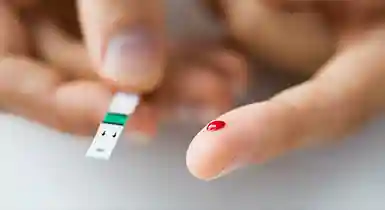
On the 14th of November is the annual World Diabetes Day with the theme “Access to Diabetes Care“. This year especially World Diabetes Day is exciting. The most common non-communicable disease affecting India today is Diabetes Mellitus. It is a metabolic disorder, in which an individual has an increased level of blood sugar. As per research, currently affects an estimated 143 million people worldwide and the number is growing rapidly. In India, about 5 percent population suffers from diabetes. Diabetes can be regarded as a potential epidemic in India with more than 62 million diabetic individuals currently diagnosed with the disease. What is World Diabetes Day? World Diabetes Day is an internationally recognized event that was established by the IDF and the World Health Organization (WHO) to address the rising concerns about diabetes. we’ll be celebrating this incredible breakthrough, the century of life-changing research it inspired, and our ambitions for the future – a world without diabetes. History of World Diabetes Day Frederick Banting and John Macleod won a Nobel Prize for discovering the treatment and surgery that has gone on to save millions of lives around the world – Insulin. Since then, our scientists have made incredible breakthroughs – from helping people with type 1 to make their own insulin, to putting type 2 into remission. And we’re getting closer to a cure for every life. All this has only been possible because of you. But there’s still more to do. This International Diabetes Day, will you help us stop diabetes forever? What is Diabetes? Diabetes is a disorder affecting the pancreas which produces the hormone insulin. Insulin helps the body use food for energy. The condition is due to either insufficient insulin being produced or no insulin being secreted by the pancreatic cells, or both. Insulin works together with glucose in the bloodstream to help it enter the body’s cells for all metabolic activity. Therefore if insulin does not functioning properly, glucose cannot enter the cells and this produces an imbalance. This end result is that glucose levels in the blood sugar tend to rise, creating a condition of high blood sugar or diabetes, and leaving the cells without glucose for the basic energy in the body. If left untreated, Diabetes can tend to cause various complications and affects the vital organs. Some Complications are Retinopathy (eye disease), Nephropathy (kidney disease) & Neuropathy (nerve disease). What are the Symptoms of Diabetes? The most common symptom of diabetes is fatigue increased thirst and hunger, along with frequent urination. Diabetes symptoms can vary from patient to patient depending on the type and age. What are the Types of Diabetes? There are two common forms of diabetes: Type 1 Diabetes and Type 2 Diabetes. What is Type 1 Diabetes? In Type 1 diabetes: Affects the age group of 20-30, but it can occur at any age In type 1 Diabetes, The insulin-producing cells are damaged and no insulin is produced in the body for it to utilise it for energy. Generally one would have to use insulin injections to control their blood glucose in this type of Diabetes. What is Type 2 Diabetes? Affects 40 yrs. of age and who are predisposed to being overweight. In this condition enough insulin is not produced or the insulin does not work optimally. It generally involves a combination of diet, weight management and exercise. Sometimes treatment also may include oral glucose-lowering medications or insulin injections. What are the Causes of Diabetes? How is Diabetes Diagnosed? 1) Fasting blood sugar and Post Prandial blood sugar level .A Normal fasting blood glucose is between 70 and 100 mg/dl. A person is said to be diabetic if his fasting blood glucose level of 126 mg/dl we say he is crossed the borderline and if the random blood glucose level is 200 mg/dl. 2) Another accurate test to measure is Glycosylated hemoglobin, or HbA1c, in the blood. This test determines blood glucose control for the past 2 to 3 months. How to Cure Diabetes? Diabetes treatment and controlled by the following: Maintaining your blood sugar level by having a balance diet, taking the medication and exercise is vital for controlling diabetes. It is advisable also to maintain Blood cholesterol and triglyceride (lipid) levels. Managing blood pressure is also essential. How to Control & Prevent Diabetes? 1) Exercise, reducing stress and proper diet is vital in managing diabetes 2) Some tips on a diabetic diet are: 3) Taking diabetic medicine in proper dosage and time 4) Monitoring your blood glucose at home if necessary 5) Carrying out laboratory test as prescribed for status of blood sugar. Living with diabetes can be difficult. You need to take full control of your diabetes…. It’s in your hands to make it better. In case of any further queries regarding diabetes surgery, treatment, investigation, and overall care do visit us at Wockhardt Hospitals. Wockhardt Hospitals, a chain of tertiary care super-specialty hospitals has more than 25 years of experience in the creation and management of Super Specialty Hospitals in India. We are a premiere hospital in the country specializing in the treatment of all medical conditions. We provide comprehensive diagnostic and treatment under one roof to our patients. Our medical speciality at Wockhardt Hospitals has renowned clinical expertise in treating diabetes and providing overall management. Wockhardt Hospitals have been regarded as centers of excellence in medical science with facilities in North Mumbai (Mira road), South Mumbai (Mumbai Central), Navi Mumbai (Vashi), Nagpur, Nasik, Rajkot and Surat. Wockhardt Hospitals is having state-of-the-art infrastructure. Our prime objective is patient safety and quality of care all levels. The guiding philosophy is to serve and enrich the Quality of Life of patients and to make life win.






